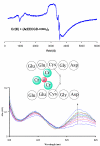An informatics search for the low-molecular weight chromium-binding peptide
- PMID: 15603587
- PMCID: PMC539358
- DOI: 10.1186/1472-6769-4-2
An informatics search for the low-molecular weight chromium-binding peptide
Abstract
BACKGROUND: The amino acid composition of a low molecular weight chromium binding peptide (LMWCr), isolated from bovine liver, is reportedly E:G:C:D::4:2:2:2, though its sequence has not been discovered. There is some controversy surrounding the exact biochemical forms and the action of Cr(III) in biological systems; the topic has been the subject of many experimental reports and continues to be investigated. Clarification of Cr-protein interactions will further understanding Cr(III) biochemistry and provide a basis for novel therapies based on metallocomplexes or small molecules. RESULTS: A genomic search of the non-redundant database for all possible decapeptides of the reported composition yields three exact matches, EDGEECDCGE, DGEECDCGEE and CEGGCEEDDE. The first two sequences are found in ADAM 19 (A Disintegrin and Metalloproteinase domain 19) proteins in man and mouse; the last is found in a protein kinase in rice (Oryza sativa). A broader search for pentameric sequences (and assuming a disulfide dimer) corresponding to the stoichiometric ratio E:D:G:C::2:1:1:1, within the set of human proteins and the set of proteins in, or related to, the insulin signaling pathway, yields a match at an acidic region in the alpha-subunit of the insulin receptor (-EECGD-, residues 175-184). A synthetic peptide derived from this sequence binds chromium(III) and forms a metal-peptide complex that has properties matching those reported for isolated LMWCr and Cr(III)-containing peptide fractions. CONCLUSION: The search for an acidic decameric sequence indicates that LMWCr may not be a contiguous sequence. The identification of a distinct pentameric sequence in a significant insulin-signaling pathway protein suggests a possible identity for the LMWCr peptide. This identification clarifies directions for further investigation of LMWCr peptide fractions, chromium bio-coordination chemistry and a possible role in the insulin signaling pathway. Implications for models of chromium action in the insulin-signaling pathway are discussed.
Figures


Similar articles
-
Distribution and chromium-binding capacity of a low-molecular-weight, chromium-binding substance in mice.J Inorg Biochem. 1984 Oct;22(2):91-102. doi: 10.1016/0162-0134(84)80018-5. J Inorg Biochem. 1984. PMID: 6502162
-
The binding of trivalent chromium to low-molecular-weight chromium-binding substance (LMWCr) and the transfer of chromium from transferrin and chromium picolinate to LMWCr.J Biol Inorg Chem. 2000 Feb;5(1):129-36. doi: 10.1007/s007750050016. J Biol Inorg Chem. 2000. PMID: 10766445
-
Low-molecular-weight chromium-binding substance (LMWCr) may bind and carry Cr(III) from the endosome.J Inorg Biochem. 2021 Oct;223:111555. doi: 10.1016/j.jinorgbio.2021.111555. Epub 2021 Jul 22. J Inorg Biochem. 2021. PMID: 34315118
-
Mechanisms of chromium action: low-molecular-weight chromium-binding substance.J Am Coll Nutr. 1999 Feb;18(1):6-12. doi: 10.1080/07315724.1999.10718821. J Am Coll Nutr. 1999. PMID: 10067653 Review.
-
Quest for the molecular mechanism of chromium action and its relationship to diabetes.Nutr Rev. 2000 Mar;58(3 Pt 1):67-72. doi: 10.1111/j.1753-4887.2000.tb01841.x. Nutr Rev. 2000. PMID: 10812920 Review.
Cited by
-
Isolation and characterization of chromium(VI)-reducing bacteria from tannery effluents and solid wastes.World J Microbiol Biotechnol. 2018 Aug 6;34(9):126. doi: 10.1007/s11274-018-2510-z. World J Microbiol Biotechnol. 2018. PMID: 30083836
-
Isolation and characterization of low-molecular-weight chromium-binding substance (LMWCr) from chicken liver.Protein J. 2008 Sep;27(6):371-5. doi: 10.1007/s10930-008-9146-z. Protein J. 2008. PMID: 18769887
-
Reduction of hexavalent chromium by Ochrobactrum intermedium BCR400 isolated from a chromium-contaminated soil.3 Biotech. 2012 Mar;2(1):79-87. doi: 10.1007/s13205-011-0038-0. Epub 2011 Nov 29. 3 Biotech. 2012. PMID: 22582159 Free PMC article.
-
Characterization of the organic component of low-molecular-weight chromium-binding substance and its binding of chromium.J Nutr. 2011 Jul;141(7):1225-32. doi: 10.3945/jn.111.139147. Epub 2011 May 18. J Nutr. 2011. PMID: 21593351 Free PMC article.
-
Quantitative analysis of trace chromium in blood samples. Combination of the advanced oxidation process with catalytic adsorptive stripping voltammetry.Anal Chem. 2006 Nov 1;78(21):7582-7. doi: 10.1021/ac060707p. Anal Chem. 2006. PMID: 17073430 Free PMC article.
References
-
- White MF. Insulin signaling in health and disease. Science. 2003;302:1710–1711. - PubMed
-
- Amos AF, McCarty DJ, Zimmet P. The rising global burden of diabetes and its complications: estimates and projections by 2010. Diabet Med. 1997;14:S5–S85. - PubMed
-
- King H, Aubert RE, Herman WH. Global Burden of Diabetes, 1995-2025. Prevelence, numerical estimates and projections. Diabetes Care. 1998;21:1414–1431. - PubMed
-
- Kopelman PG, Hitman GA. Diabetes. Exploding Type II. Lancet. 1998;352:SIV5. - PubMed
-
- Moller DE. New drug targets for type 2 diabetes and the metabolic syndrome. Nature. 2001;414:821–827. - PubMed
Grants and funding
LinkOut - more resources
Full Text Sources

